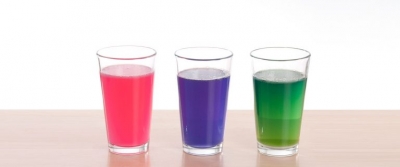
What you need:
- Red cabbage
- Water Vinegar
- Detergent
- Three glasses
- A blender
- A sieve
What to do:
1. Half fill the blender with water. Peel six cabbage leaves and put them in the blender.
2. Blend until you have red cabbage juice.
3. Sieve the juice into three glasses.
4. In the first glass, add a teaspoon of vinegar. Stir to mix
5. To the third glass, add a teaspoon of detergent. Mix that well too.
What happens:
The liquid in the first glass becomes red. The liquid in the third glass, to which detergent has been added, becomes green.
The liquid in the second glass, which is pure cabbage juice, stays purple.
Why?
It’s simple chemistry. The vinegar is an ‘acid’ whereas the detergent is a base. What do these terms mean? If you taste the vinegar, you’ll find that it tastes tangy. Detergent, on the other hand, tastes bitter (don’t try it just take our word for it). If you rub detergent between your fingers, you will find that it feels soapy and slippery.
Broadly speaking, tangy-tasting liquids are acids while bitter- tasting substances that have a soapy texture are bases. More examples of acids include lime juice, fruit juices, even milk. Substances such as baking soda and cleaning liquids are examples of bases. Almost all substances can be classified as acids or bases. But since we can’t go about tasting them we need other substances known as indicators to tell us if something is an acid or a base. Indicators are chemicals that usually change colour on coming in contact with acids and bases. In this case, red cabbage juice is an indicator. It turns red when mixed with an acid and on coming in contact with a base, it turns green. The second glass is neutral cabbage juice which acts as a reference to show you how drastic the colour change is.
Picture Credit : Google




